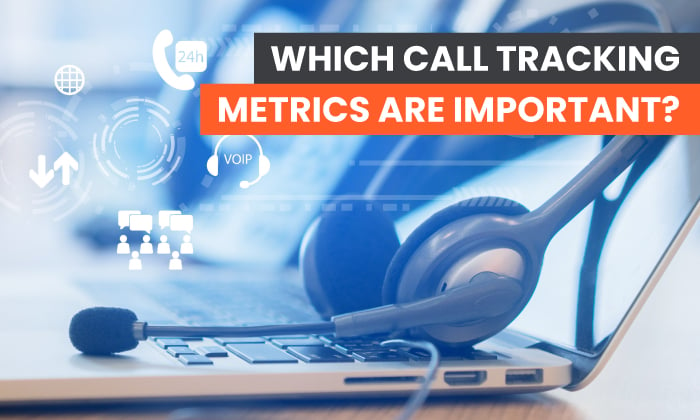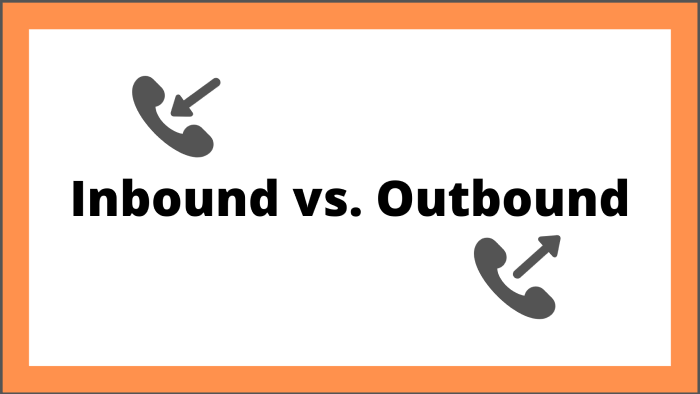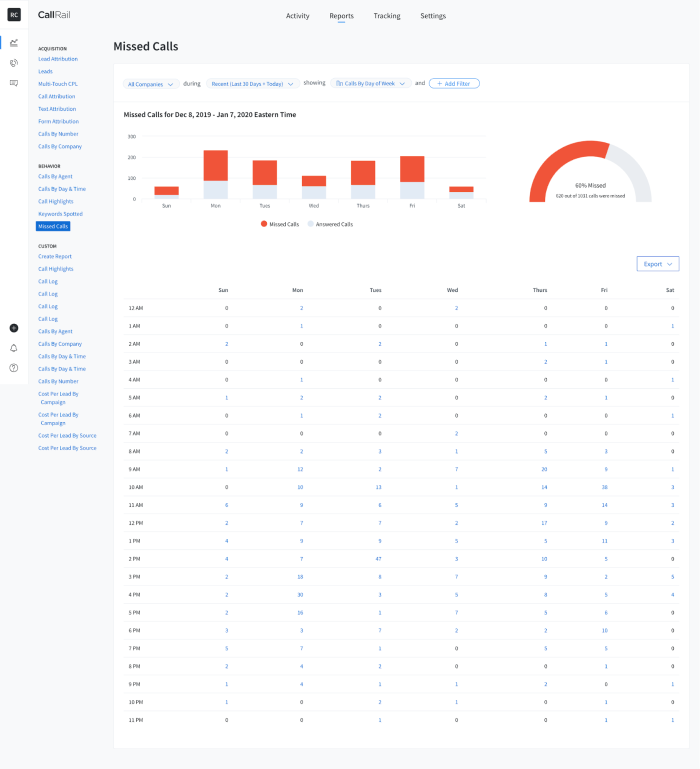
We live in a world inundated with advanced data. We’re tracking clicks, views, impressions, form completions, chatbot responses…the list goes on. One unique and often neglected area is call tracking metrics.
By implementing a standard call tracking protocol, you’ll be able to learn more about your audience and maximize the profitability of every call.
Call Tracking Metrics for Inbound vs. Outbound Calls

If someone picks up the phone to call you, chances are you have a decent campaign on your hands. However, not all calls are equal.
One crucial factor to consider before deciding on metrics is the difference between inbound and outbound call tracking metrics. You can’t measure the same data for inbound as you do for outbound.
Inbound calls refer to all the calls an individual makes to your business. For example, if someone sees an ad you’re running on Google, finds the phone number, and calls you, that’s an inbound call.
Outbound calls refer to the calls your business makes to potential customers. An example of this would be someone completing a form on your landing page and entering their phone number for you to call them. You’re making an outbound call in this case.
As you can tell, the metrics you would measure for both call types are very different. You’ll want to create a unique strategy and approach for each.
Let’s take a look at the most effective metrics for each type of call.
Call Tracking Metrics for Outbound Calls
If you’re making outbound calls in your business, you’re likely getting leads from somewhere. Whether it’s your landing page, PPC, or social media, you’ll want to track the success of your efforts.
Here are the most important outbound call metrics to track.
Volume
Call volume tells you which advertisements are generating the most calls so you can track the ROI of your marketing efforts.
If your business call volume is high, this information will be even more critical. When you have multiple salespeople calling out to customers, you’ll want to keep track of who makes which calls and how many calls they’re making on a workday.
Don’t assume this data is better left to the big businesses, though. Even if you have one or two salespeople making outbound calls, you should track the calls they make.
Lead Source
Few factors are as important as the source of leads. These call tracking metrics are crucial to your success because they tell you where your best leads come from. For example, if you have two different landing pages each asking leads for their phone number, you’ll want to keep track of which landing page drives more leads.
Even if one page is outperforming the other in terms of CTR, the page with fewer numbers might be better targeted if it yields a higher close rate from your phone calls.
You’ll never know if you’re not tracking.
Call Duration
Call duration might not seem like a critical factor, but lasting conversations generally lead to sales. If you’re continually dialing out calls that last less than 30 seconds, you might want to reconsider the source of those leads.
The ad might not be targeted properly, the text may be misleading, or you may want to consider adding negative keywords.
If you find certain campaigns yield longer conversations, callbacks, and more closes, you’ll want to pump more money into that campaign. Keep track of how long each call lasts and see if you can find any correlation between that and over or underperforming campaigns.
But don’t look at call duration alone—the length of the call is an indicator, not proof of good or bad ROI.
Time/Date
The time of day can have an enormous impact on conversions, and this information is valuable no matter what type of campaign you’re running.
With this data, you can track what time of day people are more receptive to outbound calling. Track how many voicemail boxes you get, how many callbacks you get, and the success rate of getting through based on the time you’re calling.
Over time, that data will clearly show the exact time of day and week you should call prospects for a specific campaign. If you have the data, you can even narrow it down by demographic.
Triggers/Objections
Outbound calling is all about mastering objections and figuring out how to overcome them. What phrases make people want to buy, and what phrases turn people away? If you’re not tracking this, you’re missing out.
Whether you make all the calls yourself or have salespeople, you need to keep a running tab of every objection someone throws at you.
- It’s too much money.
- We don’t have the budget right now.
- I need to check with my boss.
- I’m in the middle of a meeting.
- My boss is on vacation.
- Call back in the new year.
No objection is too big or small for you to keep track of it. Take note and supply responses for each one. This can increase your conversions and make conversations easier because you’ll have a response ready for whatever they throw your way.
Call Tracking Metrics for Inbound Calls

You’ve put together a successful campaign, and people are picking up the phone to call. That’s great. Now that you have a decent volume of calls, you need to track them to know where they’re coming from, which campaigns are performing, and who they are.
Using call tracking metrics for inbound is just as important as outbound. Here are the top inbound call metrics to track.
Lead Source
Just like you wanted to know the source of the outbound lead, you’ll want to know where inbound leads come from as well. How did they find out about you, where did they get your number, and what made them want to call?
For example, did they see a specific ad or search for a specific key term?
Knowing where they’re coming from tells you where to allocate your marketing budget. Even if you’re getting a ton of phone calls, they could all be coming from the same campaign while you have four others running at a loss.
Using Dynamic Number Insertion is a great way to do this. This strategy allows you to track each number independently so you can tell the source of a campaign right away.
PPC/Landing Page Performance
Every time someone hits your landing page, they’re likely greeted with several contact methods. They could fill out a form, use an on-site chatbot, or pick up the phone and dial. If you are tracking forms and chatbots but not phone calls, you could be missing the mark on campaign ROI.
Having different phone numbers on each landing page helps determine which one brings in the most calls. But, as I mentioned before, more calls is not always better.
Make sure you also track the success of each call, because some campaigns might bring in fewer calls but more qualified prospects that close at a higher rate.
Missed Calls
A missed call could be a missed sale. How often do callers dial your number only to get a voicemail box? Understanding how often you miss calls can give insight into staffing issues so you can adjust your staff or consider other options like educational resources on your website or a live chat feature.
First-Time Caller
If someone has never called you before, you’ll want to know what made them pick up the phone today. Keeping tabs on all the phone numbers that call you will help make this easier. When someone calls you for the first time, you can take a unique approach that caters to this potential new customer.
You’ll also want to take a deep dive into what brought them to you. What keyword did they use, what landing page did they hit, what phone number did they dial? What is their intent? How can you use this information to get more first-time callers?
Use all this data to put together a “first-time caller” action plan. Keep track of new leads and create specific sales call templates for them.
Previous Interactions
If a prospect has reached the point where they decided to call you, chances are they’ve known about you for a while and have interacted in some other way. They might have visited a landing page, clicked an ad, or interacted with you on social media.
You need to track this to determine what finally drove them over the edge. What finally got them to reach out?
Advanced marketing systems like KissMetrics provide you with data about every interaction a prospect has with you.
Call Metric Tracking Tools
As you can see, there are tons of data points you should be tracking. Tracking all of this information manually is impossible, so you’ll need a call metric tracking tool to help.
Luckily, there are plenty of call tracking metrics apps out there to help you keep an eye on what works and what doesn’t. Here are a few to consider.
CallRail
CallRail is the most popular tool for tracking call-related data. It racks phone calls from online and offline marketing, keywords, PPC, and more.
You’ll have access to information about which campaigns are performing, what time of day is best to call, and even which staff member should make the call based on their performance and the recipient’s potential demographic.
PhoneWagon
PhoneWagon is a great tool for tracking calls and gathering information on a more granular level. If you’re collecting information and you’re concerned about the performance of your employees who are making the calls, PhoneWagon can help you with that.
When you pair this type of “in-call” data with the analytics that CallRail provides, your team should have an easier time closing prospects.
WhatConverts
WhatConverts does it all, and that’s part of the reason it’s so popular. It tracks your calls, manages your leads, and provides complex data for each call.
If you have multiple points of contact such as forms, live chat, email, and phone, you can track everything on this platform. Their reporting features make them stand out, because it makes it easy to gain insights from all that data.
Conclusion
Whether you’re managing all inbound and outbound calls yourself or have a team of 80 salespeople, tracking call metrics is crucial to business success. This information provides opportunities to learn about your audience, understand your prospects, and determine what makes them act.
This information will help narrow down your marketing campaigns so you can focus on the strategies that work. Overwhelmed? Consider hiring a digital marketing expert to do it for you.
Just remember, there is no such a thing as too much data. Use one of the tools discussed above to help turn pages of data into actionable steps that will help drive your business forward.
What are the most important call tracking metrics for you?
The post Which Call Tracking Metrics Are Important? appeared first on Neil Patel.
About us and this blog
We are a digital marketing company with a focus on helping our customers achieve great results across several key areas.
Request a free quote
We offer professional SEO services that help websites increase their organic search score drastically in order to compete for the highest rankings even when it comes to highly competitive keywords.
Subscribe to our newsletter!
More from our blog
See all postsRecent Posts
- Web Hosting September 26, 2023
- Affiliate Management September 26, 2023
- Online Presence Analysis September 26, 2023

